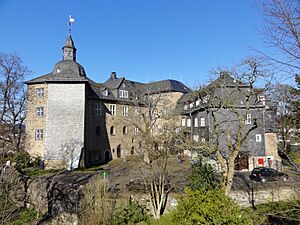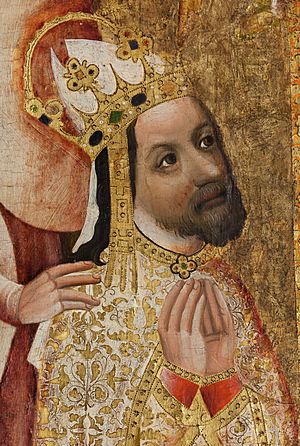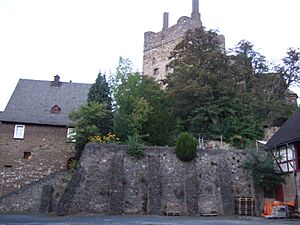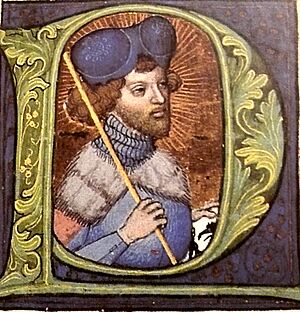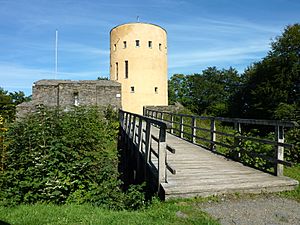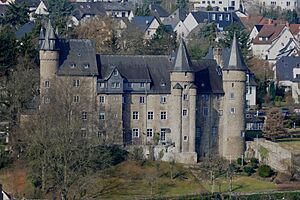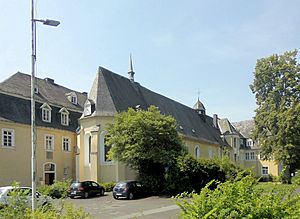John I, Count of Nassau-Siegen facts for kids
John I, Count of Nassau-Siegen (born around 1339 – died September 4, 1416) was a powerful ruler. He was the Count of Nassau-Siegen from 1350 or 1351 until his death. His family, the House of Nassau, was very important in German history.
Count John was known for being involved in many conflicts and alliances during his life. He was a brave knight, always ready for a fight or a negotiation. He worked hard to protect and even expand his lands. He made sure his family's inheritance stayed strong and free of debt. He often outsmarted his enemies, sometimes in battle, sometimes in court.
During his long rule, he gained new lands and wealth. He especially grew his family's power by dealing with the inheritance of Nassau-Hadamar. John was able to fix many problems that his father had faced.
Quick facts for kids
John I, Count of Nassau-Siegen
|
|
|---|---|
| Count of Nassau-Siegen | |
| Coat of arms | 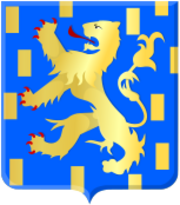 |
| Reign | 1350/1351–1416 |
| Predecessor | Otto II |
| Successor |
|
| Full name |
John I, Count of Nassau-Siegen
|
| Native name | Johann I. Graf von Nassau-Siegen |
| Born | c. 1339 |
| Died | 4 September 1416 (aged 76–77) Herborn Castle |
| Buried | Keppel Abbey |
| Noble family | House of Nassau-Siegen |
| Spouse(s) | Margaret of the Mark |
| Issue Detail |
|
| Father | Otto II of Nassau-Siegen |
| Mother | Adelaide of Vianden |
The Story of Count John I
John was born around 1339. He was the oldest son of Count Otto II of Nassau-Siegen and Countess Adelaide of Vianden.
When John's father died in battle between 1350 and 1351, young John became the Count of Nassau-Siegen. Since he was still a child, his mother, Adelaide, ruled in his place. She was a smart and strong woman. She worked to end many conflicts her husband had started with other noble families.
Adelaide also paid off many of her husband's debts. In the Nassau-Siegen area, local nobles often did what they wanted. But Adelaide kept them under control. She had to sell some land to pay debts. Yet, her agreements brought peace, allowing the county to rebuild. However, new debts arose from ongoing conflicts. In 1356, she made a deal with Landgrave Henry II of Hesse. She opened all Nassau castles to him for protection while John was young.
In the Haiger area, a powerful noble family, the Haigers, caused trouble. They tried to escape the rule of the Counts of Nassau. They thought John's young age was their chance. Heiderich von Haiger even disrespected young John. This led to a fight. The conflict hurt the countryside and its people. But Adelaide bravely defended her son's rights. She had strong support from her allies, Landgrave Henry II of Hesse and his son Otto.
The fighting ended with a legal agreement in 1357. This agreement, with 63 rules, settled the dispute. The Nassaus won control over the Haiger area. The Haiger lords became vassals, meaning they served the Nassaus. Peace and quiet followed, helping the region grow.
From 1359 to 1362, Adelaide and John paid off many important debts. Emperor Charles IV owed John's father money. So, the Emperor gave them rights to collect tolls (fees) from some rivers or lands. This often meant increasing the toll fees. Adelaide and John tried to collect from the toll at Oberlahnstein. They also had older claims against the Electorate of Mainz.
This led to a fight. In late 1362, Archbishop Gerlach of Nassau invaded Nassau-Siegen with 500 horsemen. His soldiers looted and destroyed the county. But they had to leave when floods came. In December, Gerlach and John made peace. Gerlach paid John money and gave him rights to collect tolls at Oberlahnstein for life.
John took over ruling in 1362. He immediately started a conflict with Godfrey of Heinsberg. This was over John's claims to the Lordship of Heinsberg. These claims came from his grandfather's marriage. The dispute was settled with money payments in 1363 and 1374.
Count John's Alliances and Conflicts
John joined the Sternerbund, an alliance of knights. This group formed after Landgrave Otto of Hesse died in 1366. Otto's grandfather, Landgrave Henry II, chose his nephew Herman as his successor. But Henry's grandson, Duke Otto I of Brunswick-Göttingen, was unhappy. Many Hessian nobles also disliked the new ruler.
Duke Otto easily found allies for his dispute. Count Godfrey VII of Ziegenhain led the allies. They used a silver star from Ziegenhain's coat of arms as their symbol, calling themselves "Sterners" (Star-Wearers). John I of Nassau-Siegen was eager to join. He had been an enemy of Landgrave Henry before. He wanted to get revenge for damage done to Siegerland around 1360. Also, Henry had taken control of Driedorf. John wanted it back.
In another conflict, John was captured by Lord John of Westerburg in 1370. He was released only after paying a large ransom of 10,000 guilders. They remained at peace until 1408. In 1371, John fought in the Battle of Baesweiler. He sided with the Dukes of Jülich and Guelders against the Duke of Luxembourg and Duchess of Brabant. The war with Hesse continued until about 1373. The Sterners invaded Hesse many times, taking loot and retreating to their castles. However, their main goal was not achieved. Landgrave Herman remained in power. John also did not get Driedorf back.
In 1373, John formed a new alliance against Hesse, called the Bund der alten Minne (Alliance of the Old Love). Its goal was to conquer Driedorf, and John seemed to lead it. Its members called themselves "Fellows of the Old Love." John defeated the Hessians at Wetzlar. He then plundered many areas, causing great damage. Perhaps this victory helped him drive the Hessians out of Driedorf. A 1378 agreement shows he had regained Driedorf Castle. However, it's unclear how Driedorf later returned to Hesse.
Hostilities against Hesse continued for several years after 1373. John supported anyone who had a dispute with Hesse. In 1375, he allied with Count John of Solms against Hesse. A peace deal was made in 1377. Another agreement in 1378 stated that John should keep Driedorf Castle. It also said that Hesse should dismantle a castle built near the Dill River. But Landgrave Herman did not fully accept this.
The dispute continued. In 1379, John joined a new alliance against Hesse, called the Gesellschaft mit dem Löwen (Society with the Lions). The fighting lasted over 30 years, with breaks. It stopped in 1411 but soon restarted under their sons. John also seemed to be part of another group, the Gesellschaft mit den Hörnern (Society with the Horns), for mutual defense.
On July 27, 1369, John was given the County of Arnsberg by Roman King Wenceslaus. The last count had sold it to the Electorate of Cologne in 1368. Cologne kept control, and Emperor Charles IV confirmed their ownership in 1371. John had to wait to claim his rights. However, in 1379, King Wenceslaus again gave Arnsberg to John.
John tried to take control, leading to a conflict. Agreements in 1381, 1401, and 1404 show John couldn't take Arnsberg. But he did gain sole control of the city of Siegen, which Cologne had partly owned. John also gained the right to fly the storm flag in Westphalia. This meant he could keep peace and safety in the Emperor's name. From 1392, John allowed his vassals, the Lords of Rennenberg, to fly this flag if he wasn't personally leading.
John traded inheritance claims for toll rights for Siegen with Duke William II of Jülich. This helped Siegen's trade with the Netherlands. William was related to King Edward III of England. Through William, Siegen's citizens gained special rights to trade in England. They were also free from certain taxes for city defenses and gates. During the Hundred Years' War, some knights from Siegerland even fought for England.
On November 30, 1376, John arranged a marriage for his oldest son, Adolf. Adolf was to marry Jutta, the only daughter of Count Gerhard VII of Diez. The Diez family was about to end its male line, so Jutta would inherit the County of Diez. Adolf would immediately receive lands from the Nassau-Hadamar inheritance. He would also get lands from his grandmother, Adelaide of Vianden. The marriage needed special permission from the Pope because Adolf and Jutta were distant relatives.
John used a conflict with Count John III of Sayn-Wittgenstein to expand his feudal rights. Count John III had attacked his neighbors. In 1390, Landgrave Herman of Hesse and John I, along with other nobles, united against him. They wanted to stop his harmful actions. John III's mountainous land made him hard to defeat. But after two years, he was captured and held at Dillenburg Castle.
He was released after promising to stop robbing, burning churches, and sheltering outlaws. He also had to pay a ransom. He gave up claims to serfs in Nassau-Siegen. He also gave Nassau-Siegen free hunting and fishing rights in Wittgenstein. He opened all his castles to John I. Finally, John III recognized his county as an old Nassau fief. He promised that he and his descendants would always be loyal to Nassau-Siegen.
John sometimes faced attacks from his younger brother, Henry the Swashbuckler. Henry, though a church official, was a brutal fighter. Before 1389, John built Freudenberg Castle to protect against the lords of Wildenburg and the counts of Sayn. He stopped robber knights in his county. In those lawless times, he decided to set up a special court, a "vehmic court," at Ginsburg Castle. This court needed the Emperor's permission. John received it from Roman King Wenceslaus in 1384. The court's area would stretch from Bilstein to Sayn. A judge was appointed in 1398. However, this court did not last long.
Disputes with the Counts of Solms over Greifenstein led John to buy this lordship in 1395. John also gained more land through the Nassau-Hadamar inheritance dispute. He fought with Count Rupert of Nassau-Sonnenberg and the counts of Katzenelnbogen. John gained one-third of Hadamar and Ellar Castle, two-thirds of Bad Ems, the Esterau, and Dietkirchen.
In his later years, John became an advisor to the Archbishop of Trier. He died at Herborn Castle on September 4, 1416. He was buried in Keppel Abbey near Hilchenbach. His sons Adolf I, John II, Engelbert I, and John III the Younger took over. They had already agreed in 1409 to rule together. They promised not to fight each other and to follow older agreements. If any brother tried to take something for himself, he would lose his inheritance. Adolf gave up his claim to parts of Nassau-Hadamar and other districts. The brothers ruled together after their father's death. They did not divide the lands because Adolf had no sons, the elder John was not married, and the younger John was a clergyman.
Count John's Family
John married Countess Margaret of the Mark on November 30, 1357. She died on September 29, 1409. Margaret was the daughter of Count Adolf II of the Mark and Countess Margaret of Cleves. John's parents had arranged this marriage back in 1343.
Through this marriage, John gained yearly payments from Gummersbach and revenues from Hamm. He also received a castle and city, Neustadt, and other lands as a pledge for money in 1383. He also gained hereditary claims to the Duchy of Cleves and the County of Mark.
John and Margaret were related. They both came from the same great-great-grandparents, William IV of Jülich and Richardis of Guelders.
John and Margaret had the following children:
- Count Adolf I (1362 – June 12, 1420). He became Count of Nassau-Siegen after his father. He married:
- Countess Jutta of Diez (after 1367 – August 14, 1397).
- Kunigonda of Isenburg-Limburg in 1402 (died March 15, 1403).
- Count John II with the Helmet (died early May 1443 at Dillenburg Castle). He also became Count of Nassau-Siegen.
- Count Engelbert I (born around 1370 – died May 3, 1442 in Breda). He also became Count of Nassau-Siegen. He married Lady Joanne of Polanen in Breda on August 1, 1403 (January 10, 1392 – May 15, 1445).
- Henry, mentioned in 1389 as a student in Cologne. In 1399, he was a church official in Xanten. He was last mentioned in 1401.
- Count John III the Younger (died April 18, 1430). He also became Count of Nassau-Siegen.
Sources
|
John I, Count of Nassau-Siegen
House of Nassau-Siegen
Born: c. 1339 Died: 4 September 1416 |
||
| Regnal titles | ||
|---|---|---|
| Preceded by Otto II |
Count of Nassau-Siegen December 1350/January 1351 – 4 September 1416 |
Succeeded by Adolf I John II with the Helmet Engelbert I John III the Younger |


